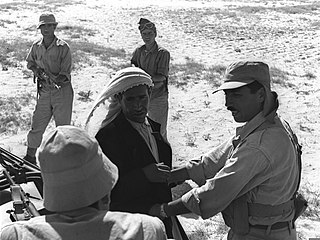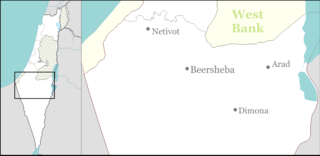
The Qibya massacre occurred during Operation Shoshana, a reprisal operation that occurred in October 1953 when Israeli troops under future prime minister Ariel Sharon attacked the village of Qibya in the West Bank, which was then under Jordan's control, and killed Palestinian civilians.

Moshe Dayan was an Israeli military leader and politician. As commander of the Jerusalem front in the 1948 Arab–Israeli War, Chief of Staff of the Israel Defense Forces (1953–1958) during the 1956 Suez Crisis, and especially as Defense Minister during the Six-Day War in 1967, he became a worldwide fighting symbol of the new state of Israel.
The history of the Israel Defense Forces (IDF) intertwines in its early stages with history of the Haganah.

Black September, also known as the Jordanian Civil War, was an armed conflict between Jordan, led by King Hussein, and the Palestine Liberation Organization (PLO), led by chairman Yasser Arafat. The main phase of the fighting took place between 16 and 27 September 1970, though certain aspects of the conflict continued until 17 July 1971.

The South Lebanon conflict, designated by Israel as the Security Zone in Lebanon Campaign, was a protracted armed conflict that took place in southern Lebanon from 1985 to 2000. It saw fighting between Israel and the Catholic Christian-dominated South Lebanon Army (SLA) against Hezbollah-led Shia Muslim and left-wing guerrillas within the Israeli-occupied "Security Zone"; the SLA had military and logistical support from the Israel Defense Forces over the course of the conflict and operated under the jurisdiction of the Israeli-backed South Lebanon provisional administration, which succeeded the earlier Israeli-backed State of Free Lebanon. It can also refer to the continuation of the earlier conflict in this region involving the growing Palestinian insurgency in South Lebanon against Israel following the expulsion of the Palestine Liberation Organization (PLO) from Jordan after Black September. Historical tensions between Palestinian refugees and Lebanese factions contributed another layer to the Lebanese Civil War (1975–1990), which saw the Maronite-led Lebanese Front and the Shia Amal Movement at war with the PLO. Hence, the South Lebanon conflict can partly be seen as an extension of the civil war that ended in 1990.

The Battle of Karameh was a 15-hour military engagement between the Israel Defense Forces (IDF) and combined forces of the Palestine Liberation Organization (PLO) and the Jordanian Armed Forces (JAF) in the Jordanian border town of Karameh on 21 March 1968, during the War of Attrition. It was planned by Israel as one of two concurrent raids on PLO camps, one in Karameh and one in the distant village of Safi.

Palestinian return to Israel refers to the movement of Palestinians back into the territory of present Israel.

Palestinian fedayeen are militants or guerrillas of a nationalist orientation from among the Palestinian people. Most Palestinians consider the fedayeen to be "freedom fighters", while most Israelis consider them to be "terrorists".

Reprisal operations were raids carried out by the Israel Defense Forces in the 1950s and 1960s in response to frequent fedayeen attacks during which armed Arab militants infiltrated Israel from Syria, Egypt, and Jordan to carry out attacks on Israeli civilians and soldiers. Most of the reprisal operations followed raids that resulted in Israeli fatalities. The goal of these operations – from the perspective of Israeli officials – was to create deterrence and prevent future attacks. Two other factors behind the raids were restoring public morale and training newly formed army units. A number of these operations involved attacking villages and Palestinian civilians in the West Bank, including the 1953 Qibya massacre.
Events in the year 1957 in Israel.
Events in the year 1956 in Israel.
Events in the year 1955 in Israel.
The Yehud attack was an attack on a civilian house in the village of Yehud carried out by a Palestinian fedayeen squad on 12 October 1953. Three Israeli Jewish civilians, a mother and her infant children, were killed in the attack.

The Negev desert road ambush was a terrorist attack which occurred on Thursday, 4 October 1956 at Highway 25, Israel when a squad of 10 armed Palestinian fedayeen fired at two civilian vehicles. As a result, 5 Israeli civilians were killed and 1 was injured.
The Misgav Am hostage crisis, which began during the night of April 7, 1980, was a raid carried out by a squad of five Palestinian militants belonging to the Iraqi-backed Arab Liberation Front militant organization, on the northern Israeli kibbutz of Misgav Am in which the militants captured a group of toddlers and babies in the children's sleeping quarters of the kibbutz and held them as hostages. The event ended the next day with the takeover of the terrorist stronghold by Israeli special forces.

Operation Black Arrow was an Israeli military operation carried out in Gaza on 28 February 1955. The operation targeted the Egyptian Army. Thirty-eight Egyptian soldiers were killed during the operation as were eight Israelis.

The Khan Yunis massacre took place on 3 November 1956, perpetrated by the Israel Defense Forces (IDF) in the Palestinian town of Khan Yunis and the nearby refugee camp of the same name in the Gaza Strip during the Suez Crisis.

The Palestinian Fedayeen insurgency was an armed cross-border conflict, which peaked between 1949 and 1956, involving Israel and Palestinian militants, mainly based in the Gaza Strip, under the nominal control, of the All-Palestine Protectorate – a Palestinian client-state of Egypt declared in October 1948, which became the focal point of the Palestinian fedayeen activity. The conflict was parallel to the Palestinian infiltration phenomenon. Hundreds were killed in the course of the conflict, which declined after the 1956 Suez War.











